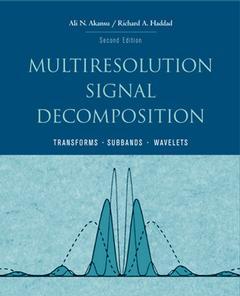Multiresolution Signal Decomposition (2nd Ed.) Transforms, Subbands, and Wavelets
Auteurs : Akansu Ali N., Haddad Richard A.

The uniqueness of this book is that it covers such important aspects of modern signal processing as block transforms from subband filter banks and wavelet transforms from a common unifying standpoint, thus demonstrating the commonality among these decomposition techniques. In addition, it covers such "hot" areas as signal compression and coding, including particular decomposition techniques and tables listing coefficients of subband and wavelet filters and other important properties.
The field of this book (Electrical Engineering/Computer Science) is currently booming, which is, of course, evident from the sales of the previous edition. Since the first edition came out there has been much development, especially as far as the applications. Thus, the second edition addresses new developments in applications-related chapters, especially in chapter 4 "Filterbrook Families: Design and Performance," which is greatly expanded.
1. Introduction 2. Orthogonal Transforms 3. Theory of Subband Decomposition 4. Filter Bank Families: Design and Performance 5. Time-Frequency Representations 6. Wavelet Transform 7. Applications
A. Resolution of the Identity and Inversion B. Orthonormality in Frequency C. Problems
Richard A. Haddad received the B.E.E, M.E.E, and Ph.D. degrees in 1956, 1958, and 1962 respectively from the Polytechnic Institute of Brooklyn. He had been on the Electrical Engineering Faculty of Polytechnic University from 1961 to 1995. During his tenure there, he had served in various capacities. From 1981 to 1987, he was Associate Dean and then Director of the Westchester Graduate Center. During leaves of absence, he has served as a Member of the Technical Staff at Bell Telephone Laboratories, Whippany, N.J. and as first Director of the Engineering Division at the Institut National d'Electricite et d'Electronique, Boumerdes, Algeria. He has also lectured and consulted in signal processing at universities in Italy, People's Republic of China.
Presently he is Professor and Chair, Department of Electrical and Computer Engineering, New Jersey Institute of Technology. New Jersey.
He is a senior memeber of IEEE and also an elected member of Eta Kappa Nu, Tau Beta Pi, and Sigma Xi, and the New York Academy of Sciences.
- Unified and coherent treatment of orthogonal transforms, subbands, and wavelets
- Coverage of emerging applications of orthogonal transforms in digital communications and multimedia
- Duality between analysis and synthesis filter banks for spectral decomposition and synthesis and analysis transmultiplexer structures
- Time-frequency focus on orthogonal decomposition techniques with applications to FDMA, TDMA, and CDMA
Date de parution : 10-2000
Ouvrage de 499 p.
18.5x23.3 cm
Épuisé



